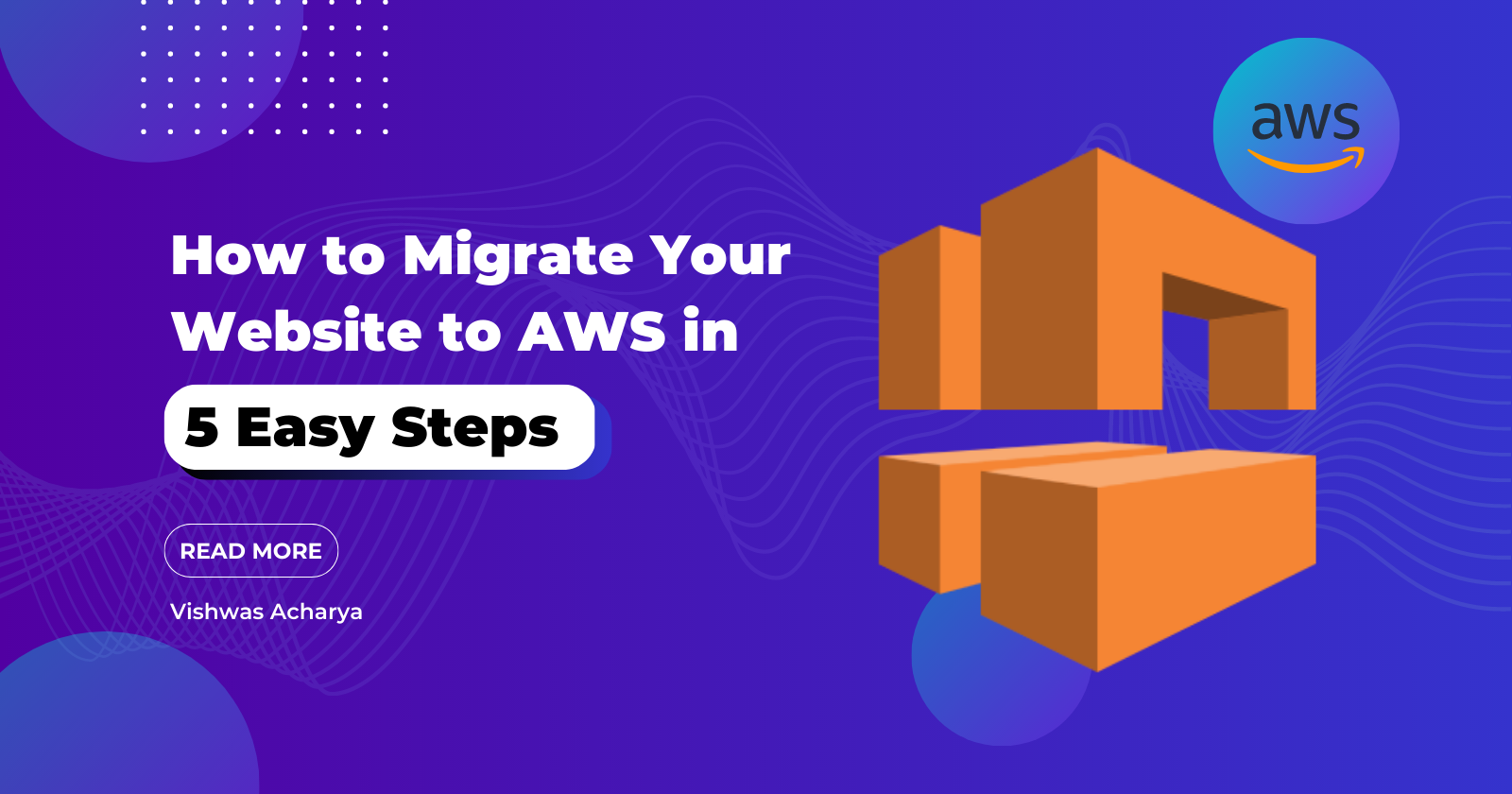How to Migrate Your Website to AWS in 5 Easy Steps
 Vishwas Acharya
Vishwas Acharya
If you are planning to migrate your website to AWS, then you're in the right place. Amazon Web Services (AWS) is one of the most popular cloud platforms available today, providing a range of services to help businesses manage their website infrastructure. In this article, we'll guide you through 5 easy steps on how to migrate your website to AWS.
Pre-Migration Steps
Before migrating your website to AWS, there are a few things you should consider to ensure a smooth migration process.
1. Understand Your Current Infrastructure
To migrate your website to AWS, you should first understand your current infrastructure. Make a list of all the components and services that make up your websites, such as web servers, databases, storage, and load balancers. This will help you choose the right AWS services to use for your migration.
2. Choose the Right AWS Service
AWS offers a wide range of services, and it's essential to choose the right service for your website. For example, Amazon Elastic Compute Cloud (EC2) is a popular service for hosting web servers, while Amazon Relational Database Service (RDS) is ideal for database management. Make sure you choose the right service based on your website's requirements.
3. Create a Migration Plan
Creating a migration plan is critical to ensure a smooth transition. Consider the migration schedule, downtime, data transfer, and testing. A migration plan should be created, including all the necessary steps.
Set Up AWS Infrastructure
Once you have completed the pre-migration steps, you can start setting up your AWS infrastructure.
1. Create an AWS Account
To use AWS services, you need to create an AWS account. Sign up for an AWS account and verify your identity by providing your payment information.
2. Create a Virtual Private Cloud (VPC)
A VPC is a virtual network that allows you to launch AWS resources into a virtual network. Create a VPC, and configure its IP address range, subnets, and route tables.
3. Set Up Networking
Configure the networking components, such as Internet Gateway, NAT Gateway, and Route 53. These components are essential for connecting your website to the internet.
Migrate Your Website
Now that you have set up your AWS infrastructure, it's time to migrate your website to AWS.
1. Transfer Your Website Content
To transfer your website content to AWS, you can use AWS DataSync or AWS Storage Gateway. These services can help you transfer large amounts of data quickly and securely.
2. Test Your Website on AWS
Once you have transferred your website content, test your website on AWS. Make sure all the components are working correctly, and the website is running smoothly.
Post-Migration Steps
After migrating your website to AWS, there are a few post-migration steps you should take to optimize your AWS environment.
1. Optimize Your AWS Environment
Optimize your AWS environment by using AWS services
2. Configure DNS and Switch Your Domain Name
To make your website accessible on AWS, you need to configure the Domain Name System (DNS). Configure your DNS settings to point to your website on AWS. You should also switch your domain name to AWS to ensure all traffic goes through your new infrastructure.
3. Update Your Security and Monitoring
After migrating your website to AWS, you should ensure that your security and monitoring are up to date. Configure security groups and access controls to protect your website from potential security threats. Set up monitoring tools to ensure that your website is running smoothly and detect any issues before they become critical.
Conclusion
Migrating your website to AWS can seem like a daunting task, but by following these 5 easy steps, you can ensure a smooth transition. By understanding your current infrastructure, choosing the right AWS service, creating a migration plan, setting up your AWS infrastructure, and optimizing your environment after migration, you can successfully migrate your website to AWS.
FAQs
How long does it take to migrate a website to AWS?
- Migrating a website to AWS can take anywhere from a few hours to a few days, depending on the complexity of the website and the amount of data being transferred.
What are the benefits of migrating a website to AWS?
- Migrating a website to AWS can provide benefits such as increased scalability, better performance, and improved security.
Do I need technical skills to migrate my website to AWS?
- While technical skills can be helpful, AWS provides many tools and resources that can make the migration process accessible to non-technical users.
Can I migrate my website to AWS without experiencing downtime?
- It is possible to migrate your website to AWS without experiencing downtime by using techniques such as DNS migration and staggered migration.
What happens if I encounter issues during the migration process?
- AWS provides extensive documentation, support, and resources to help users overcome any issues that may arise during the migration process.
By Vishwas Acharya 😉
Checkout my other content as well:
YouTube:
Podcast:
Book Recommendations:
Subscribe to my newsletter
Read articles from Vishwas Acharya directly inside your inbox. Subscribe to the newsletter, and don't miss out.
Written by

Vishwas Acharya
Vishwas Acharya
Embark on a journey to turn dreams into digital reality with me, your trusted Full Stack Developer extraordinaire. With a passion for crafting innovative solutions, I specialize in transforming concepts into tangible, high-performing products that leave a lasting impact. Armed with a formidable arsenal of skills including JavaScript, React.js, Node.js, and more, I'm adept at breathing life into your visions. Whether it's designing sleek websites for businesses or engineering cutting-edge tech products, I bring a blend of creativity and technical prowess to every project. I thrive on overseeing every facet of development, ensuring excellence from inception to execution. My commitment to meticulous attention to detail leaves no room for mediocrity, guaranteeing scalable, performant, and intuitive outcomes every time. Let's collaborate and unleash the power of technology to create something truly extraordinary. Your dream, my expertise—let's make magic happen! Connect with me on LinkedIn/Twitter or explore my work on GitHub.